Work - Joint Steering Committee for Development of RDA
Work - Joint Steering Committee for Development of RDA
Work - Joint Steering Committee for Development of RDA
Create successful ePaper yourself
Turn your PDF publications into a flip-book with our unique Google optimized e-Paper software.
Resource<br />
Description and Access<br />
A Cataloging Code <strong>for</strong> the Future<br />
(and related IFLA initiatives:<br />
FRBR, FRAD, IME ICC)<br />
IGBIS<br />
Durban, South Africa<br />
August 24, 2007<br />
Barbara B. Tillett, Library <strong>of</strong> Congress
• IFLA Initiatives<br />
• What is FRBR?<br />
• FRAD, FRSAR<br />
• IME ICC<br />
Topics today<br />
• What is <strong>RDA</strong> and why a new standard?<br />
• <strong>RDA</strong> goals, structure, and content<br />
• Preparing <strong>for</strong> <strong>RDA</strong><br />
2
What is<br />
FRBR?<br />
• IFLA’s Functional<br />
Requirements <strong>for</strong><br />
Bibliographic Records<br />
(FRBR)<br />
• User tasks<br />
• Find<br />
• Identify<br />
• Select<br />
• Obtain<br />
• Entities, Relationships,<br />
Attributes<br />
• Mandatory elements <strong>for</strong> a<br />
national level bibliographic<br />
record
Other International<br />
<strong>Development</strong>s<br />
• IFLA’s Functional<br />
Requirements <strong>for</strong><br />
Bibliographic<br />
Records (FRBR)<br />
• FRAD <strong>for</strong> authority<br />
data<br />
• Updating the Paris<br />
Principles (IME<br />
ICC)<br />
• IFLA Meeting <strong>of</strong><br />
Experts on an<br />
International<br />
Cataloguing Code
Vocabulary<br />
• “Book”<br />
–Door prop<br />
(item)<br />
–“publication”<br />
at bookstore<br />
any copy<br />
(manifestation)
Vocabulary<br />
•“Book”<br />
–Who translated?<br />
(expression)<br />
–Who wrote?<br />
(work)
<strong>Work</strong><br />
Intellectual/<br />
artistic content<br />
Expression<br />
is realized through<br />
Physical -<br />
recording <strong>of</strong><br />
content<br />
Manifestation<br />
is embodied in<br />
Item<br />
is exemplified by<br />
7
Relationships Inherent<br />
to the Group 1 Entities<br />
• <strong>Work</strong> “is realized by” an expression<br />
• Expression “is embodied in” a<br />
manifestation<br />
•Manifestation “is exemplified by”<br />
an item<br />
•Item
<strong>Work</strong><br />
Expression<br />
Manifestation<br />
Relationships<br />
• Inherent among<br />
the entities<br />
Item<br />
• Content<br />
relationships<br />
among works<br />
Whole-Part<br />
Accompanying
EQUIVALENT<br />
Family <strong>of</strong> <strong>Work</strong>s<br />
DERIVATIVE<br />
DESCRIPTIVE<br />
Micro<strong>for</strong>m<br />
reproduction<br />
Copy<br />
Exact<br />
reproduction<br />
Reprint<br />
Facsimile<br />
Simultaneous<br />
“publication”<br />
Translation<br />
Editions<br />
Revision<br />
Variations or versions<br />
Illustrated<br />
edition<br />
Abridged<br />
edition<br />
Expurgated<br />
edition<br />
Arrangement<br />
Slight<br />
modifications<br />
Summary<br />
Abstract<br />
Digest<br />
Free<br />
translation<br />
Dramatization<br />
Novelization<br />
Screenplay<br />
Libretto<br />
Change <strong>of</strong> genre<br />
Adaptations<br />
Parody<br />
Imitations<br />
Same style or<br />
thematic content<br />
Review<br />
Criticism<br />
Annotated<br />
edition<br />
Casebook<br />
Evaluation<br />
Commentary<br />
Original<br />
Same work<br />
New work<br />
Same<br />
Expression<br />
New Expression<br />
Cataloging Rules<br />
cut-<strong>of</strong>f point<br />
New <strong>Work</strong><br />
10<br />
B. Tillett<br />
Dec. 2001
Group 1 Entities’ Attributes<br />
• <strong>Work</strong><br />
• ID<br />
• Title<br />
• Date<br />
• etc.<br />
• Expression<br />
• ID<br />
• Title<br />
• Form<br />
• Date<br />
• Language<br />
• etc.<br />
• Manifestation<br />
• ID<br />
• Title<br />
• Statement <strong>of</strong> responsibility<br />
• Edition<br />
• Imprint (place, publisher,<br />
date)<br />
• Form/extent <strong>of</strong> carrier<br />
• Terms <strong>of</strong> availability<br />
• Mode <strong>of</strong> access<br />
• etc.<br />
• Item<br />
• ID<br />
• Provenance<br />
• Location<br />
• etc.
<strong>Work</strong><br />
Expression<br />
Group 2<br />
Entities<br />
FRBR<br />
Manifestation<br />
Item<br />
is owned by<br />
is produced by<br />
is realized by<br />
is created by<br />
Person<br />
Corporate Body<br />
many
<strong>Work</strong><br />
has as subject<br />
has as subject<br />
has as subject<br />
<strong>Work</strong><br />
Expression<br />
Manifestation<br />
Item<br />
Person<br />
Corporate Body<br />
Concept<br />
Object<br />
Event<br />
Place<br />
FRBR<br />
Group 3<br />
Subject <strong>of</strong><br />
<strong>Work</strong>s<br />
many
Possible FRBR applications<br />
Scenario A - Now<br />
Authority<br />
<strong>Work</strong>/<br />
Expression<br />
Uni<strong>for</strong>m<br />
Title<br />
Bibliographic<br />
Person<br />
Manifestation<br />
Series<br />
(work/expression)<br />
Uni<strong>for</strong>m<br />
Title<br />
Concept<br />
Holding<br />
Item
Authority<br />
<strong>Work</strong>/<br />
Expression<br />
Uni<strong>for</strong>m<br />
Title<br />
Person/<br />
Corporate<br />
body<br />
Scenario B<br />
Person/<br />
Corporate<br />
body<br />
Series<br />
(work/expression)<br />
Uni<strong>for</strong>m<br />
Title<br />
Concept<br />
Bibliographic<br />
Manifestation<br />
Holding<br />
Item
• Collocation<br />
Better organization to catalog<br />
• Easier cataloging<br />
FRBR Benefits<br />
• Reduction in cataloging load<br />
<strong>Work</strong> only cataloged once <strong>for</strong> all expressions <strong>of</strong> it<br />
Expression only cataloged once <strong>for</strong> all manifestations<br />
<strong>of</strong> it<br />
Item cataloging (already simple) remains the same
FRBR Benefits<br />
Circulation: Place holds at “<strong>Work</strong>” or<br />
“Expression” level rather than only at<br />
manifestation level<br />
(VTLS and OCLC demonstrate this)
Serial Example<br />
Each <strong>of</strong> the five basic titles in the “family” <strong>of</strong> Atlantic<br />
Monthly is a “sub-work” under the Super <strong>Work</strong>.
This the Manifestation level record which has in<strong>for</strong>mation<br />
like the title page, imprint, LCCN, and ISSN.
WORK<br />
EXPRESSION<br />
MANIFESTATION<br />
20
• Functional Requirements <strong>for</strong><br />
Authority Data<br />
FRAD<br />
• Extension <strong>of</strong> the FRBR model to<br />
authority control
FRAD<br />
Bibliographic<br />
Entities<br />
known by<br />
Names and/or<br />
Identifiers<br />
basis <strong>for</strong><br />
Controlled Access<br />
Points
FRAD extension to FRBR<br />
FRBR<br />
Entities:<br />
Person<br />
Family<br />
Corporate Body<br />
<strong>Work</strong><br />
Expression<br />
Manifestation<br />
Item<br />
Concept<br />
Object<br />
Event<br />
Place<br />
Name<br />
Identifier<br />
Access Point<br />
Rules<br />
Agency
Cataloguing Principles<br />
• 1961 –<br />
IFLA’s “Paris<br />
Principles”
IME ICC<br />
Goals & Objectives<br />
• Goal<br />
• Increase the ability to share cataloguing<br />
worldwide by<br />
• Promoting standards<br />
• Objectives<br />
• Develop “Statement <strong>of</strong> International<br />
Cataloguing Principles”<br />
• See if rules/practices can get closer<br />
together<br />
• Make recommendations <strong>for</strong> an<br />
International Cataloguing Code
IME ICC Regional Meetings<br />
• IME ICC1 – Europe/Anglo-American<br />
http://www.d-nb.de/standardisierung/afs/imeicc_index.htm<br />
• IME ICC2 – Latin America-Caribbean<br />
http://www.loc.gov/imeicc2<br />
• IME ICC3 – Middle East<br />
http://www.loc.gov/loc/ifla/imeicc/<br />
• IME ICC4 – Asia<br />
http://www.nl.go.kr/icc/icc/main.php
IME ICC5<br />
• 2007 August 14-15 subSaharan<br />
Africa<br />
• Hosted by the<br />
National Library <strong>of</strong> South Africa,<br />
Pretoria, South Africa<br />
http://www.imeicc5.com
New standard:<br />
why?<br />
• Simplify rules<br />
• Encourage use as a content standard<br />
<strong>for</strong> metadata schema<br />
• Encourage international applicability<br />
• Provide more consistency<br />
• Address current problems<br />
• Principle-based<br />
• To build cataloger’s judgment<br />
• Encourage application <strong>of</strong> FRBR/FRAD<br />
28
Why not just keep<br />
revising AACR2?<br />
• AACR2<br />
• 1978<br />
• 1988<br />
• 1998<br />
• 2002<br />
29
Background<br />
• 1997: International Conference on the<br />
Principles and Future <strong>Development</strong> <strong>of</strong><br />
AACR, Toronto<br />
• Worldwide experts invited by the JSC<br />
• Reviewed principles<br />
• Content vs. carrier<br />
• Logical structure <strong>of</strong> the rules<br />
• Seriality<br />
• Internationalization<br />
30
From AACR3 to<br />
<strong>RDA</strong><br />
• April 2005 – decided to start afresh by<br />
rethinking and restructuring AACR3<br />
• Came as a result <strong>of</strong> concerns that a<br />
revision <strong>of</strong> AACR2 would not<br />
accommodate digital resources<br />
• Adopted the name Resource Description<br />
and Access<br />
31
New Cataloging<br />
Environment<br />
• Wide range <strong>of</strong> in<strong>for</strong>mation carriers:<br />
wider depth & complexity <strong>of</strong> content<br />
• Metadata (bibliographic in<strong>for</strong>mation)<br />
created by a wider range <strong>of</strong> personnel in<br />
and outside libraries; some using new<br />
metadata schemas (Dublin Core, etc.)<br />
• Descriptive data in digital <strong>for</strong>m (ONIX,<br />
etc.)<br />
32
GOALS:<br />
<strong>RDA</strong> will be …<br />
• A new standard <strong>for</strong> resource<br />
description and access<br />
• Designed <strong>for</strong> the digital environment<br />
• Web-based product<br />
• paper also available<br />
• Description and access <strong>of</strong> all digital and<br />
analog resources<br />
• Resulting records usable in the digital<br />
environment (Internet, Web OPACs, etc.)<br />
33
<strong>RDA</strong> will be …<br />
• “A multinational content standard<br />
providing bibliographic description and<br />
access <strong>for</strong> the variety <strong>of</strong> media and<br />
<strong>for</strong>mats collected by libraries today”<br />
• Developed <strong>for</strong> use in English language<br />
environment;<br />
• it can also be used in<br />
other language<br />
communities<br />
34
Content vs. display<br />
• <strong>RDA</strong> will be a content standard --not a<br />
display or encoding standard<br />
• Independent <strong>of</strong> the encoding communication<br />
<strong>for</strong>mat (e.g., MARC 21, MODS)<br />
• Independent <strong>of</strong> display <strong>for</strong>mat (e.g., OPAC<br />
labels, ISBD)<br />
• International Standard Bibliographic<br />
Description (ISBD) display in<strong>for</strong>mation in<br />
Appendix to <strong>RDA</strong><br />
• <strong>RDA</strong>-created records can be displayed in an<br />
ISBD display if desired<br />
35
<strong>RDA</strong> will …<br />
• Support FRBR user tasks<br />
• Find, identify, select, obtain<br />
• Enable users <strong>of</strong> library catalogs,<br />
etc., to find and use resources<br />
appropriate to their in<strong>for</strong>mation<br />
needs<br />
36
Who develops and<br />
supports <strong>RDA</strong>?<br />
<strong>Committee</strong><br />
<strong>of</strong><br />
Principals<br />
AACR Fund<br />
Trustees/<br />
Publishers<br />
<strong>Joint</strong> <strong>Steering</strong><br />
<strong>Committee</strong><br />
ALA<br />
CC:DA<br />
ACOC BL CCC CILIP LC<br />
37
JSC and Project<br />
Management Team<br />
38
Creating <strong>RDA</strong><br />
• Process <strong>of</strong> creating <strong>RDA</strong><br />
• Editor drafts chapters<br />
• JSC reviews chapters<br />
• Editor revises chapters<br />
• JSC constituencies (and others)<br />
review chapters<br />
• JSC considers comments and requests<br />
changes to text by the Editor<br />
39
<strong>RDA</strong> Proposed<br />
Structure<br />
• General introduction<br />
• Part A – Description and access<br />
• Part B – Authority control (Access point<br />
control)<br />
• Part C?<br />
• Appendices<br />
• Capitalization, Abbreviations, Initial articles<br />
• Presentation (ISBD display, OPAC display, etc.)<br />
• Glossary<br />
• Index<br />
40
Part A<br />
Chapters 0-5<br />
0. Introduction<br />
1. General guidelines <strong>for</strong> resource<br />
description<br />
2. FRBR ”Identify” the resource<br />
3. Carrier description - FRBR “Select”<br />
4. Content description - FRBR “Select”<br />
5. Acquisition and access in<strong>for</strong>mation -<br />
FRBR “Obtain”<br />
41
Part A Ch. 6-7<br />
“Relationships”<br />
FRBR user task “Find”<br />
• Chapter 6:<br />
Relationships<br />
between FRBR<br />
Group 1 and<br />
Group 2 entities<br />
Persons<br />
Corporate bodies<br />
Families<br />
• Chapter 7:<br />
Relationships<br />
among FRBR<br />
Group 1 entities<br />
<strong>Work</strong>s<br />
Expressions<br />
Manifestations<br />
Items<br />
42
Part B<br />
Access Point Control<br />
• Choice <strong>of</strong> access points<br />
• General guidelines <strong>for</strong> access point control<br />
• Access points (preferred <strong>for</strong>ms and<br />
variants) <strong>for</strong>:<br />
•Persons, Families, Corporate bodies,<br />
Places<br />
•<strong>Work</strong>s, Expressions, etc.<br />
• Other in<strong>for</strong>mation used in access point<br />
control (entity identifiers, sources, etc.)<br />
43
• Elements that are data about<br />
data<br />
• “Description based on…”<br />
• Etc.<br />
Part C?<br />
44
New Terminology<br />
AACR2 terms<br />
Heading<br />
Authorized heading<br />
Main Entry<br />
Added Entry<br />
Authority control<br />
Uni<strong>for</strong>m title<br />
<strong>RDA</strong> terms<br />
Access point<br />
Preferred access point<br />
Access point/creator <strong>of</strong> work<br />
Access point<br />
Access point control<br />
Preferred title<br />
Name <strong>of</strong> the work (to include<br />
name <strong>of</strong> creator when<br />
applicable)<br />
45
New elements<br />
• Media, Carrier, and Content Types to<br />
replace GMDs<br />
• Other examples:<br />
• File characteristics <strong>for</strong> digital materials<br />
• Video <strong>for</strong>mat characteristics<br />
• Custodial in<strong>for</strong>mation <strong>for</strong> archival<br />
resources<br />
• Braille characteristics<br />
46
How many<br />
elements?<br />
• Required mandatory data<br />
elements (instruction 1.4)<br />
• Within the text, data elements<br />
will be labelled as:<br />
• “Required”<br />
• “Optional”<br />
47
Transcription<br />
• Importance <strong>of</strong> transcription <strong>of</strong> data<br />
to identify the resource varies<br />
• Rare books – very important!<br />
• Digital materials – maybe not as<br />
important<br />
• “Take what you see”<br />
• Correction <strong>of</strong> inaccuracies elsewhere<br />
• Facilitating automated data capture<br />
48
Customizing <strong>RDA</strong><br />
Web Tool<br />
• Instructions will be coded by type<br />
<strong>of</strong> content, mode <strong>of</strong> issuance, etc.:<br />
• Can create a customized version <strong>of</strong><br />
the Web-based <strong>RDA</strong> to see only the<br />
instructions you need or want to<br />
see<br />
• Cartographic instructions<br />
• Serial instructions<br />
• Etc.<br />
49
Preparing <strong>for</strong> <strong>RDA</strong> …
Questions and<br />
Answers<br />
• FAQ (“Frequently Asked Questions”)<br />
on adopting <strong>RDA</strong> and other topics<br />
available on the JSC Web site:<br />
http://www.collectionscanada.ca/jsc/rda.html<br />
51
<strong>RDA</strong> Records in<br />
MARC Format<br />
• Most <strong>RDA</strong> data elements can be<br />
incorporated into MARC 21<br />
• A few changes in MARC 21:<br />
• New data elements to replace GMDs<br />
• Possibly some other modifications<br />
necessary<br />
• <strong>RDA</strong> and Dublin Core: mappings,<br />
further discussions<br />
52
Making decisions …<br />
• Required data elements + which others?<br />
• Which alternatives and options?<br />
• Who decides how to apply <strong>RDA</strong>?<br />
• National libraries<br />
• Other governing bodies: OCLC, the Program<br />
<strong>for</strong> Cooperative Cataloging<br />
• Individual institutions<br />
53
Retrospective catalog<br />
maintenance?<br />
• No: Intend <strong>for</strong> <strong>RDA</strong> records to be<br />
compatible<br />
• Need <strong>for</strong> retrospective adjustments<br />
when integrating <strong>RDA</strong> and AACR2<br />
records will be minimal, if at all<br />
54
Draft Reviews<br />
• Mar.-June 2007: Chapter 3 “Carrier”<br />
• July–Sept. 2007: Chapters 6 and 7<br />
“Relationships”<br />
• Dec. 2007-Mar. 2008: Part B “Access<br />
Point Control”<br />
• July-Sept. 2008: Complete draft <strong>of</strong> <strong>RDA</strong><br />
• Early 2009: First release <strong>of</strong> <strong>RDA</strong><br />
55
Commenting<br />
on <strong>RDA</strong> Drafts<br />
• <strong>RDA</strong> drafts & documents available at:<br />
http://www.collectionscanada.ca/jsc/rda.html<br />
• In<strong>for</strong>mal discussion: subscribe to <strong>RDA</strong>-L<br />
(link on page above)<br />
• Formal comments: send to Chair <strong>of</strong> JSC,<br />
Deirdre Kiorgaard, dkiorgaa@nla.gov.au<br />
56
<strong>RDA</strong> Web Tool<br />
Prototype<br />
• View/listen to a 3-minute demonstration<br />
<strong>of</strong> <strong>RDA</strong> Online<br />
www.rdaonline.org<br />
• Complete a brief survey – we want your<br />
feedback!<br />
57
Training <strong>for</strong> <strong>RDA</strong><br />
• Catalogers will need some training in<br />
<strong>RDA</strong> – hope it’s more like “orientation”<br />
• Groups that provide training are<br />
beginning to make plans<br />
• Online product will assist with learning<br />
58
<strong>RDA</strong> Products<br />
• Online (Web Tool) product first:<br />
• Different pricing structures<br />
• Additional <strong>for</strong>mats: co-publishers<br />
want in<strong>for</strong>mation from you<br />
• Focus groups at ALA Annual<br />
Conference in June 2007<br />
• Questions also to be posted online<br />
<strong>for</strong> your responses<br />
59
Summary<br />
• Internationally agreed principles<br />
• IME ICC<br />
• Conceptual models<br />
• FRBR<br />
• FRAD<br />
• Collaborative ef<strong>for</strong>t<br />
• Resulting records <strong>for</strong> use in Web<br />
environment<br />
• 2009<br />
60


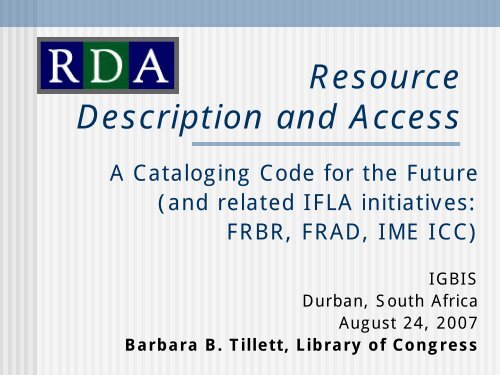

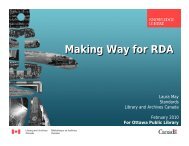
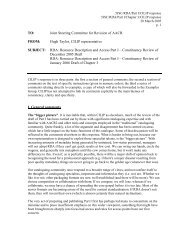
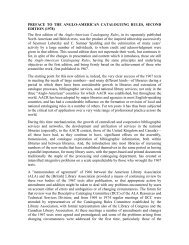
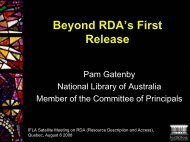

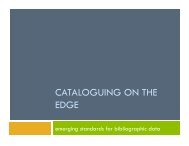

![Presentation slides [PDF] - Joint Steering Committee for ...](https://img.yumpu.com/41621230/1/190x143/presentation-slides-pdf-joint-steering-committee-for-.jpg?quality=85)

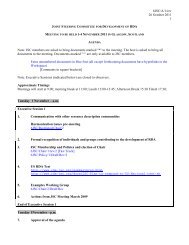
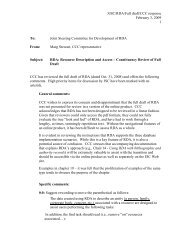
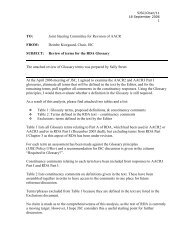
![Presentation slides [PDF] - Joint Steering Committee for ...](https://img.yumpu.com/35256207/1/190x143/presentation-slides-pdf-joint-steering-committee-for-.jpg?quality=85)
